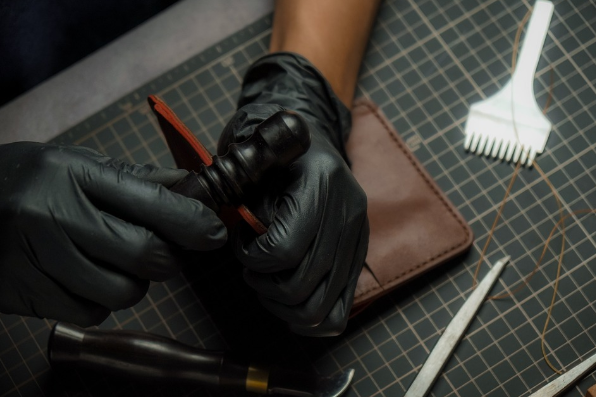Customizing leather wallets has become increasingly popular as a way to express personal style and creativity. Whether you want to refresh an old wallet or design a new one, wallet customization with leather paint allows you to transform a simple accessory into a unique piece of art. The key to a successful project lies in using the right techniques and materials, particularly high-quality leather paint that ensures a lasting and vibrant finish.
In this guide, you'll learn about the different types of leather used in wallets, the essential tools and materials you'll need, and a step-by-step process for painting leather wallets. Additionally, we’ll explore advanced techniques for creating custom wallet designs, troubleshooting common issues, and maintaining your painted wallet over time.
Understanding Leather Types for Wallets

Before diving into the painting process, it’s crucial to understand the different types of leather used in wallets. Each type of leather reacts differently to paint, so knowing what you’re working with will help you achieve the best results.
- Full-Grain Leather: This is the highest quality leather available, known for its durability and natural texture. Full-grain leather retains the hide’s original markings, giving it a rugged, authentic look. It's a great choice for creating custom wallet designs that will last for years.
- Top-Grain Leather: Slightly more processed than full-grain leather, top-grain leather is sanded down to remove imperfections, resulting in a smoother surface. It’s easier to paint on and provides a consistent finish.
- Genuine Leather: Made from the lower layers of the hide, genuine leather is more affordable but less durable. It’s often used in budget-friendly wallets and may require more preparation before painting to ensure good paint adhesion.
- Suede: A type of split leather with a soft, napped finish. Suede can be challenging to paint due to its absorbent nature, but it offers a unique texture for leather wallet art.
Understanding the type of leather you're working with will guide you in choosing the appropriate paint and techniques, ensuring a successful wallet customization project.
Tools and Materials Needed

For a successful wallet customization project, having the right tools and materials is essential. Here’s a comprehensive list to get you started:
- Leather Paints: High-quality leather paints are crucial for achieving a professional finish. These paints are flexible, durable, and resistant to cracking, making them ideal for painting wallets.
- Brushes: Invest in a variety of brushes, including fine-tipped brushes for detailed work and broader brushes for larger areas. Synthetic brushes are often preferred for their smooth application.
- Leather Cleaner and Conditioner: Properly preparing the leather surface is key to ensuring the paint adheres well. A leather cleaner removes dirt and oils, while a conditioner keeps the leather supple.
- Masking Tape: Use masking tape to protect areas of the wallet you don’t want to paint. This will help you achieve clean lines and a polished finish.
- Sealant: A clear sealant will protect your painted design from wear and tear, ensuring it remains vibrant over time.
Using high-quality products, will make a significant difference in the longevity and appearance of your custom wallet designs.
Preparing Your Wallet for Painting
Preparation is a crucial step in the wallet customization process. Properly cleaning, conditioning, and masking the leather will ensure that the paint adheres well and that your design turns out as planned.
- Cleaning: Start by cleaning the wallet with a leather cleaner. This removes any dirt, oils, or other residues that could prevent the paint from adhering properly. Use a soft cloth to apply the cleaner and wipe it away with a clean, damp cloth.
- Conditioning: After cleaning, apply a leather conditioner to keep the leather soft and flexible. Conditioning the leather also helps to prevent the paint from cracking as the wallet is used over time.
- Masking: Use masking tape to cover any areas of the wallet you don’t want to paint, such as the edges, stitching, or interior. This ensures that your design has clean, crisp lines and that no paint ends up where it shouldn’t.
- Sketching Your Design: Before you start painting, lightly sketch your design onto the wallet using a pencil or chalk. This will serve as a guide when you begin applying paint and help ensure that your design is proportionate and well-placed.
Step-by-Step Guide to Painting Leather Wallets
With your wallet prepped and your design sketched, it’s time to start painting. Here’s a step-by-step guide to help you achieve a professional finish.
- Choosing the Right Paint and Colors: Select high-quality leather paints, like those from Angelus Direct, to ensure your design lasts. Choose colors that complement the leather’s natural tone and your design concept.
- Applying the Base Coat: Begin by applying a thin, even base coat of paint across the surface of the wallet. This first layer acts as a foundation and helps subsequent layers adhere better. Allow the base coat to dry completely before moving on.
- Layering Paints for Depth and Texture: Build up layers of paint gradually, allowing each one to dry fully before applying the next. This layering technique creates depth and texture, giving your design a rich, vibrant appearance.
- Detailing and Finishing Touches: Use fine-tipped brushes to add details, such as outlines, shading, or highlights. These finishing touches will make your design pop and give it a professional finish.
- Sealing the Paint for Durability: Once your design is complete, apply a clear sealant to protect the paint from scratches, moisture, and fading. Make sure to allow the sealant to dry fully before using the wallet.
Advanced Techniques for Custom Wallet Designs

(Source: @unique__streets)
If you want to take your leather wallet art to the next level, consider incorporating these advanced techniques:
- Stenciling vs. Freehand Painting: Stenciling is a great way to achieve precise, repeatable patterns. You can purchase pre-made stencils or create your own. Freehand painting, on the other hand, allows for more creativity and unique designs. Both techniques have their merits, depending on the look you're going for.
- Creating Textures and Effects: Experiment with different tools and techniques to create textures and effects on your wallet. For example, use a sponge to dab paint for a textured finish, or blend colors while they’re still wet to create a gradient effect.
- Incorporating Mixed Media: Combine paint with other materials, such as embroidery, metal accents, or fabric, to create a multi-dimensional design. This approach can add complexity and interest to your wallet, making it a true work of art.
Troubleshooting Common Issues
Even with careful planning, issues can arise during the painting process. Here’s how to troubleshoot some common problems:
- Fixing Cracked or Peeling Paint: If the paint cracks or peels, it may be due to improper preparation or applying too thick a layer of paint. To fix this, gently sand the affected area and reapply a thin coat of paint, followed by a sealant.
- Correcting Mistakes Without Damaging the Leather: If you make a mistake while painting, you can remove the paint with a cotton swab dipped in leather cleaner. Be gentle to avoid damaging the leather, and repaint the area once it’s clean.
- Maintaining Color Vibrancy Over Time: Over time, the colors on your wallet may fade due to exposure to sunlight or moisture. To keep your design looking fresh, reapply a thin layer of paint and seal it with a UV-protective sealant.
Caring for Your Painted Leather Wallet
Proper care and maintenance will help your painted wallet last for years to come. Here are some tips to keep it in top condition:
- Cleaning and Conditioning the Painted Wallet: To clean your wallet, use a soft cloth to wipe away dirt and dust. If deeper cleaning is needed, use a mild leather cleaner and avoid scrubbing the painted areas. Condition the leather regularly to keep it soft and prevent the paint from cracking.
- Long-Term Maintenance Tips: Store your wallet in a cool, dry place away from direct sunlight when not in use. Avoid exposing it to water or excessive moisture, and reapply a sealant periodically to protect the paint.
Inspiration and Ideas for Custom Wallet Designs

(Source: @mr.s.custom)
Looking for inspiration? Here are some creative ideas to spark your imagination:
- Nature-Inspired Designs: Use floral patterns, leafy vines, or animal motifs to create a design that reflects your love of the outdoors.
- Geometric Patterns: Bold, modern, and eye-catching, geometric patterns are perfect for creating a contemporary look.
- Cultural and Tribal Art: Incorporate elements of cultural or tribal art into your design, such as symbols, patterns, or colors that hold personal significance.
These examples showcase the endless possibilities of custom wallet designs. Whether you prefer a minimalist approach or a detailed, intricate design, the choice is yours.
Customizing your leather wallet is a rewarding way to express your creativity and personal style. By following the steps outlined in this guide, you can transform a simple wallet into a unique accessory that stands out. From understanding the different types of leather to mastering advanced painting techniques, you now have the knowledge and tools needed to create stunning custom wallet designs.
If you're ready to start your project, make sure you have the right materials on hand. Explore the range of high-quality leather paints and supplies available at Angelus Direct. With the right products and a bit of creativity, you can create a wallet that not only looks amazing but also lasts for years to come.
FAQs
- Can I paint any type of leather wallet?
Yes, you can paint most types of leather wallets, but the type of leather will affect how the paint adheres and how the final design looks. Full-grain and top-grain leathers are ideal for painting, while suede requires special techniques due to its absorbent nature.
- What should I do if my paint starts to crack?
Cracked paint is often a result of improper preparation or using the wrong type of paint. To fix it, gently sand the area with fine-grit sandpaper, apply a new thin layer of high-quality leather paint, and finish with a sealant to protect the repair.
- How do I ensure my painted design lasts?
To ensure your design lasts, use high-quality leather paints, apply a clear sealant after painting, and regularly condition the leather to keep it supple. Avoid exposing the wallet to excessive moisture or direct sunlight. Angelus Direct offers high-quality leather paints designed specifically for leather, ensuring your customizations last for long period.
- Can I use other types of paint on leather?
While it’s possible to use other types of paint, they may not adhere well or last as long as leather-specific paints. For the best results, it’s recommended to use paints that are specifically formulated for leather.
- How do I remove paint from areas where I made a mistake?
If you make a mistake, use a cotton swab dipped in leather cleaner to carefully remove the paint. Be gentle to avoid damaging the leather, and allow the area to dry completely before repainting.

